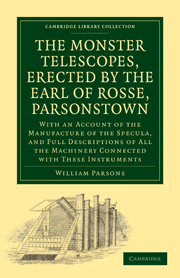 The Monster Telescopes, Erected by the Earl of Rosse, Parsonstown
The Monster Telescopes, Erected by the Earl of Rosse, Parsonstown PART I - The Manufacture of the Three Foot Speculum, and the Machinery of the Small Telescope
Published online by Cambridge University Press: 01 March 2011
Summary
Lord Rosse having satisfied himself by experiments with lenses that the Refracting Telescope could not be much improved, turned his attention to Reflectors; and as the first object of experimenters had always been to increase the magnifying power and light by the construction of as large a mirror as possible, so was it to this point that his Lordship's attention was also directed.
Previous to his experiments, there had not been any instrument constructed, with the exception of Sir W. Herschell's, which had given an opportunity of sufficiently well enjoying the advantage of the Reflecting Telescope; and even of this it has been lately stated, that it possessed but little, if any, practical superiority over others of smaller size.
Since Newton manufactured his Specula until the present day, there have been several opinions both as to the metals to be employed in their construction, and the quantities in which they should be mixed—some have recommended various proportions of tin and copper; some have added arsenic; some silver; some antimony; and others, the three together—the general aim of all the operators being to increase the whiteness, and to diminish the porosity and brittleness of the compound; for the last named property has destroyed a much greater number of Specula than it has allowed to be completed—it is the “asses' bridge” over which few have been fortunate enough to travel.
- Type
- Chapter
- Information
- The Monster Telescopes, Erected by the Earl of Rosse, ParsonstownWith an Account of the Manufacture of the Specula, and Full Descriptions of All the Machinery Connected with These Instruments, pp. 1 - 30Publisher: Cambridge University PressPrint publication year: 2010First published in: 1844


